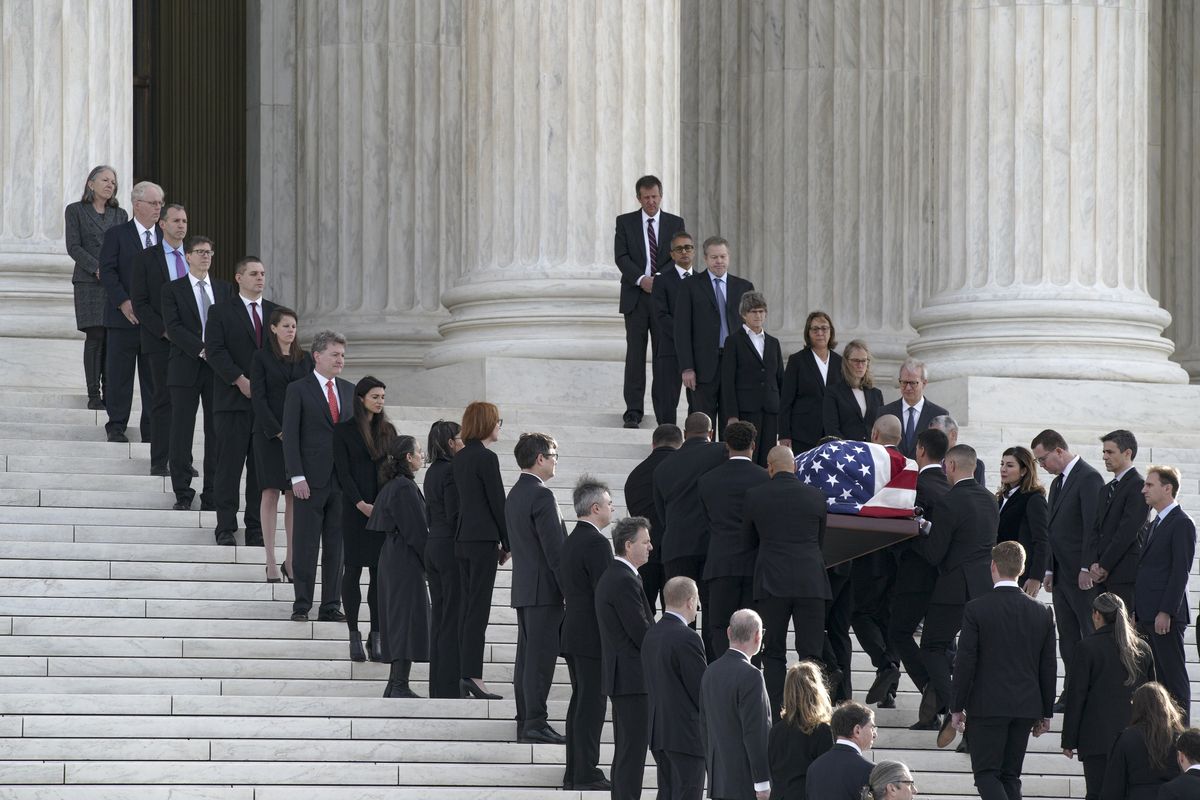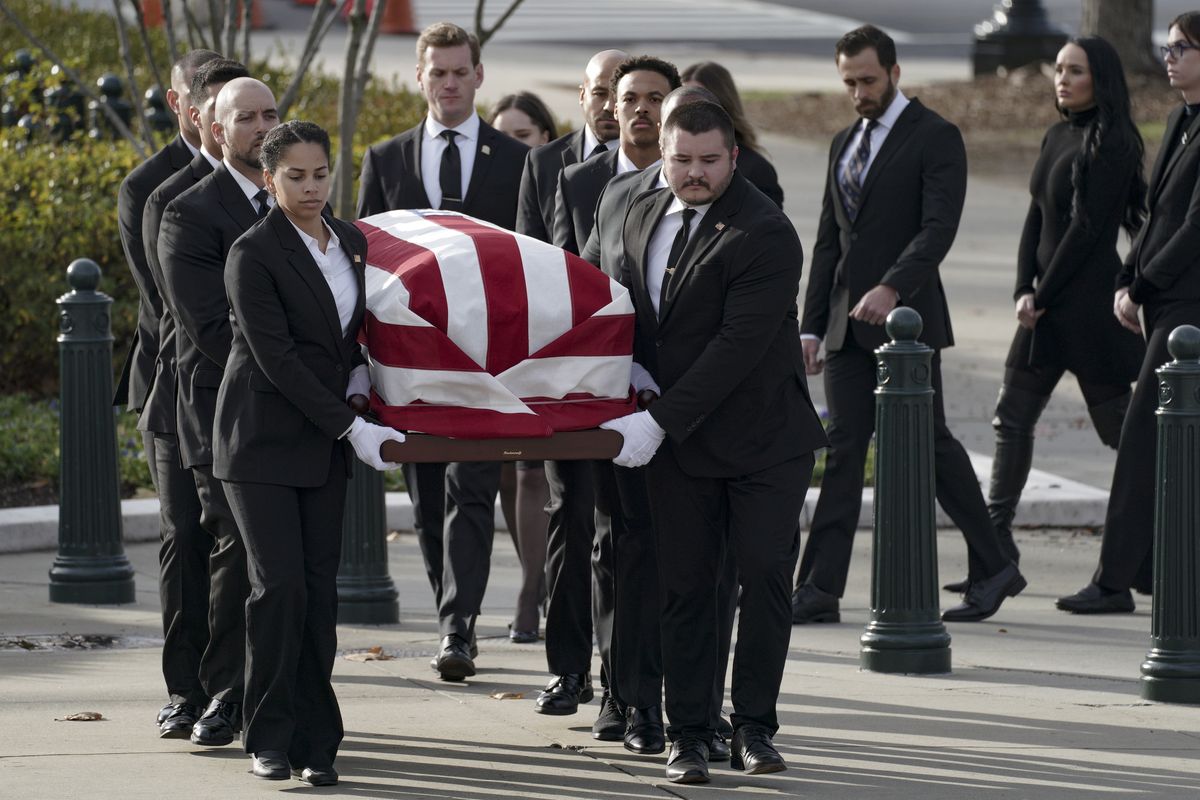Justice Sandra Day O’Connor lying in repose at the Supreme Court
The casket of Sandra Day O'Connor arrives at the Supreme Court on Monday. (Bonnie Jo Mount/The Washington Post)
Justice Sandra Day O’Connor was remembered for “cowgirl grit” and her pivotal role on the Supreme Court as her family and colleagues began a day of honoring the first woman to serve on the nation’s highest court.
“The way Sandra went, the court followed,” said Justice Sonia Sotomayor, who spoke on behalf of the court as O’Connor’s flag-draped casket was brought into the court’s Great Hall, where she is lying in repose.
Sotomayor, the third woman nominated to the court, said the trailblazer would be pleased that “four sisters” now serve on the nine-member court. “Sandra, may you rest in peace,” Sotomayor said, her voice breaking.
During a private ceremony took place before the public entered the court to pay their respects. All the members of the current court lined up in order of seniority on one side of the casket with O’Connor’s three sons and their wives, while her grandchildren and other family members were on the other side.
O’Connor, 93, died Dec. 1 of complications connected with advanced dementia, probably Alzheimer’s disease, and a respiratory illness, according to the court. Nominated by President Ronald Reagan, she served on the Supreme Court from 1981 until her retirement in 2006.
O’Connor’s casket is resting on the Lincoln Catafalque, a simple pine-board bier constructed to support the casket of Abraham Lincoln in 1865. Since 1873, it has been used for Supreme Court justices and others. Two simple flower arrangements flanked a portrait of O’Connor completed in 1999. Members of the public can pay their respects until 8 p.m.
Prayers were led by the Rev. Jane E. Fahey, who served as a clerk to O’Connor in the 1982 term and then became a minister after a 20-year law practice. Fahey remembered O’Connor as a “trailblazing inspiration” whose “cowgirl grit” left an indelible mark on her clerks. She drew laughter when she recalled O’Connor allowing a photocopy of her hand so that clerks could reference it when they needed a pat on the back.
About 9:25 a.m., approximately 80 of O’Connor’s former clerks emerged from inside the court and walked down the plaza steps, forming two symmetrical lines, awaiting to receive the casket. They stood in the sun as their suit jackets, dresses and skirts flapped in the wind.
Officers then escorted the casket team, family and honorary pallbearers down the steps between the lines of clerks before a black hearse arrived.
With white gloves on their hands, the team members took the flag-draped casket into their arms and journeyed up the stairs toward the entrance. People flowed in behind before the event opened to the public at 10:30 a.m.
During her time on the court, O’Connor became known for her independence among the ideologically divided justices, making her a key vote in several cases involving issues such as abortion and race-conscious university admissions.
Before being appointed, O’Connor served as assistant attorney general of Arizona, on the state Senate, as a superior court judge and on the state court of appeals. Post-retirement, O’Connor founded iCivics, which focuses on furthering civic education.
JP Hogan, a local blogger and poet, was first in line. Hogan said he remembers being in high school when O’Connor became the first female justice. His father, a lawyer from Connecticut, was sworn in as an officer of the court years later.
“It’s a historic event,” Hogan said of O’Connor’s repose.
For as long as Heather Maher, 42, could remember, O’Connor has been her “hero.” She was appointed the year Maher was born. When Maher was in kindergarten, she was determined to be a Supreme Court justice like O’Connor, she said.
Maher, from Rhode Island, said that when O’Connor became sick, she vowed to travel to D.C. to pay her respects at her repose. “I’ve admired the path she laid and the bridges she made for other women to follow behind her,” Maher said. “She’s a testament of resiliency.”
Though Maher didn’t become a lawyer, she is a business owner in a male-dominated field, she said. “She always talked about being visible as a woman in a position of power… . That’s her legacy,” Maher said.
Maher also noted O’Connor’s civics organization, iCivics, and how the justice aimed to bring civility to today’s political discourse through civics education. “She really wanted people to educate themselves about our government and how our government works,” Maher said. “To disagree, but to do so agreeably.”
The public can line up on the sidewalk on the East Capitol Street side of the court to enter through the visitor entrance, according to the court.
An invitation-only funeral at Washington National Cathedral is scheduled for Tuesday.

